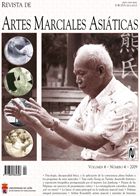Tai-chi estilo Xiong na Formosa: desenvolvimento histórico e exposição fotográfica protagonizada pelo mestre Lin Jianhong
DOI:
https://doi.org/10.18002/rama.v4i4.149Palavras-chave:
Taiji, tai chi, Taiwan, artes marciaisResumo
Este artigo apresenta um ramo do tai-chi-chuan da família Yang, pouco conhecido fora da Formosa. Denomina-se estilo “Xiong”, devido a Xiong Yanghe (1888~1981). O pouco que se publicou em inglês sobre o mestre Xiong é confuso e, por vezes, contraditório. Utilizando fontes publicadas em chinês (incluindo os próprios escritos de Xiong), documentos inéditos dos seus discípulos mais destacados, sítios Web taiwandeses relativos à temática, observações pessoais e documentos fotográficos, a informação que aqui se apresenta deverá proporcionar uma visão completa do tai-chi-chuan estilo Xiong. Utilizaram-se as fontes na língua inglesa para apresentar o marco sócio-político que influenciou de maneira profunda o início do desenvolvimento do tai-chi-chuan da família Yang. As principais conclusões afectam a linhagem Xiong, a conservação da arte e o seu significado para o entendimento dos ramos do tai-chi-chuan como arte marcial e exercício de saúde.
Downloads
Métricas alternativas
Referências
ANÓNIMO, (1984). National arts master Xiong Yanghe commemorative collection. (s.l.).
ANÓNIMO, (1987). Mr. Xiong’s 100th birthday commemorative special edition. (s.l.).
DEMARCO, M. (1992). The origin and evolution of taijiquan. Journal of Asian Martial Arts, 1(1): 8-25.
GALLAGHER, P. (2007). Drawing silk: Masters’ secrets for successful tai chi practice. Charleston, SC: BookSurge.
HAYWARD, R. (2000). T’ai-chi ch’uan: Lessons with master T.T. Liang. St. Paul, MN: ShuKuang Press.
HUCKER, C. (1975). China’s imperial past: An introduction to Chinese history and culture. Stanford, CA: Stanford University Press.
KUHN, P. (1970). Rebellion and Its Enemies in Late Imperial China: Militarization and Social Structure, 1796~1864. Cambridge, MA: Harvard University Press.
KURLAND, H. (2003). “History of a rare t’ai-chi form: San shou.” http://www.selfgrowth.com/articles/Kurland3.html. Descargada el 16 de Julio de 2009.
KURLAND, H. (May 1998). “Hsiung Yang-Ho’s san shou form.” T’ai chi Ch’uan and Wellness Newsletter. Descargada el 16 de Julio de 2009.
LIN, CAOLAI (2007). Yang family old frame Xiong style taijiquan. DVD. Yilan, Taiwan: Chin-yu Martial Art Study Association.
LU, S. (Yun, Z., Trans.) (2006). Combat techniques of taiji, xingyi, and bagua. Berkeley, CA: Blue Snake Books.
OLSON, S. (1992). The teachings of master T.T. Liang: Imagination becomes reality, the complete guide to the 150 posture solo form. St. Paul, MN: Dragon Door Publications.
OLSON, S. (1999). T’ai chi sensing-hands: A complete guide to t’ai chi t’ui-shou training from original Yang Family records. Burbank, CA: Multi-Media Books.
OLSON, S. (1999). T’ai chi thirteen sword: A sword master’s manual. Burbank, CA: MultiMedia Books.
RUSSELL, J. (2004). The tai chi two-person dance: Tai chi with a partner. Berkeley, CA: North Atlantic Books.
SCHURMANN, F. & SCHELL, O. (1967). Republican China: Nationalism, war, and the rise of Communism 1911-1949. New York: Vintage Book.
SHERIDAN, J. (1977). China in Disintegration: The Republican Era in Chinese history 1912~1949. New York: The Free Press.
WAKEMAN, F. (1977). The fall of imperial China. New York: The Free Press. Wile, D. (1996). T’ai-chi touchstones: Yang family secret transmissions. Brooklyn, NY: Sweet Chi Press.
WILE, D. (1996). T’ai-chi touchstones: Yang family secret transmissions. Brooklyn, NY: Sweet Chi Press.
XIONG, Y.H. (1962). Autobiography. Auto-publicada.
XIONG, Y.H. (1963). The taijiquan explained. Taipei: Taiwan China Book Printing House.
XIONG, Y.H. (1971). Taiji swordsmanship illustrated. Yilan, Taiwan: Lu Feng Printing and Publishing House.
XIONG, Y.H. (1975). The taijiquan explained. 3ª edición. Taipei: Huge Distribution Planning Company.
YANG, QINGYU (1976). Xiong style taijiquan long form, push-hands, and sword form. Colección cinematográfica privada.
YANG, QINGYU (1988). Autobiography. Auto-publicada.
YANG, QINGYU (n.d.). A brief biography of Xiong Yanghe. Auto-publicada.
Downloads
Publicado
Como Citar
Edição
Secção
Licença
Direitos de Autor (c) 2012 Michael A. DeMarco

Este trabalho encontra-se publicado com a Licença Internacional Creative Commons Atribuição-NãoComercial-CompartilhaIgual 4.0.
Os autores que publicam nesta Revista estão de acordo com os seguintes termos:
- Os autores cedem, de forma exclusiva, os direitos de exploração (reprodução, distribuição, comunicação pública, transformação) à Universidade de Léon, podendo estabelecer, em separado, acordos adicionais para a distribuição não exclusiva da versão do artigo publicado na Revista (por exemplo: alojar no repertório institucional ou publicá-lo num livro), com o reconhecimento da publicação inicial nesta Revista.
- O trabalho encontra-se na Creative Commons Attribution-Non Commercial-Share Alike 4.0 International License. Pode-se consultar aqui o resumo e o texto legal da licença.
- Permite-se, e sugere-se, que os autores difundam electronicamente as versões pré-impressão (versão antes de ser avaliada) e pós-impressão (versão avaliada e aceite para publicação das suas obras antes da sua publicação), favorecendo a sua circulação e difusão, e com ela o possível aumento da sua citação e alcance pela comunidade académica.











